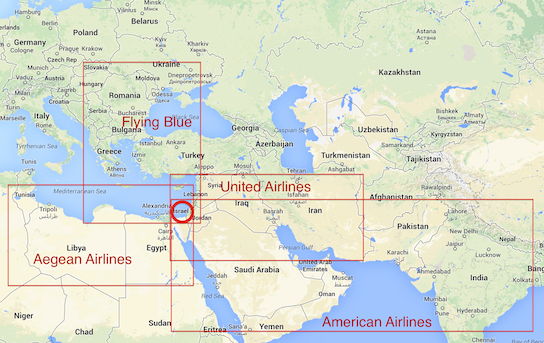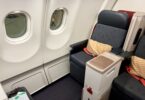One thing you do not want to do – never use airline award charts and geographical designations as a tool for learning geography! There are some very confusing assignments of countries to continents and regions among the charts, but that is not a bad thing. If you know what to look for and how to use it, the airline geographical award charts can be very helpful to you.
Airline Award Geography
First of all, most airlines have award charts that are broken down by continent, zone, or region. When looking at these breakdowns, it is important to remember that these do not accurately reflect typical international geographical markings. If you become familiar with airline geography, it can help you pinpoint what are the best programs to use for your particular destinations.
Regions
One of the (most popular) ways that airlines breakdown award charts for use is by regions. These regions align somewhat closely to continental definitions but they provide a further breakdown within those continents. They also have some strange names (like Northern South America)! Here are some of the typical breakdowns:
- North America
- Central America
- South America 1 (or Northern South America)
- South America 2 (or Southern South America)
- Europe (some go on to designate Europe 1, Europe 2, etc)
- Northern Africa
- Central Africa
- Southern Africa
- Asia 1 (or Northern Asia)
- Central Asia (or Indian Subcontinent)
- Asia 2 (or Southern Asia)
- Oceania
- Australia (some group Oceania and Australia together into South Pacific)
Now, how does this affect award travel? For one thing, it can add a substantial amount of miles to an award if you are wanting your destination to be in one of the southern zones instead of a northern zone. An example is Bolivia – United and American call it Southern South America which requires 60,000 miles but Delta calls it Northern South America which requires 45,000 miles. So, if you want to go to Bolivia, it would require cheaper miles if you flew with Delta Skymiles instead of AAdvantage miles or United miles.
Another (great) instance is Israel – American Airlines classifies it as Indian Subcontinent/Middle East which requires 90,000 miles (roundtrip), United classifies it as Middle East which requires 80,000 miles
[table “” not found /]See that? Just by knowing which program to use, you can save up to 30,000 miles on a roundtrip ticket to Israel! Who ever knew that Israel was located in Europe (Air France)? Or is it located in Africa (Aegean)? Fortunately, when it comes to award miles, different airlines will handle different countries with various region assignments.
Here is another one – Singapore from North America.
[table “” not found /]So, in this case, it would be better to use Alaska miles to fly on Cathay Pacific to Singapore than the other options presented.
Transiting Regions
Then we come on the fun part of transiting through some of the more expensive regions to get to the cheaper regions. One of my favorites is using Delta Skymiles to fly through Australia and then on with Virgin Australia – as part of the same ticket. To fly in coach to Australia on Delta is 100,000 miles. To fly to, say Papua New Guinea, it only takes 80,000 miles. Well, you have to go through Australia to get to Papua New Guinea with Virgin Australia, so you could actually stay for a couple of days in Australia before continuing on and do it for 20,000 miles less than just going to Australia!
A couple of years ago, it was possible to do the same thing with United. They used to charge 65,000 miles to the Philippines. If you made the Philippines (or other countries in that region) your final destination, you could visit Australia first (or on the way back) and save the 15,000 miles it would have required if you made Australia destination.
This can be very helpful if you want to make a visit in a more expensive region – just try to route through it first as a stopover before continuing on to your destination in the cheaper region. Remember, this will not work with all airlines but it can be very helpful for some!
Low Cost Carriers
For some regions, the cost in miles to get there can be quite a bit higher than nearby regions. In some of those instances, the countries might literally be miles away from each other but the mile cost to fly to one is 15,000 – 20,000 miles higher than the other one. In those instances, it may make more sense to use the cheaper country/region as your final destination and then use low cost air carriers or other forms of transportation to transit to the city/country you wanted to really visit. This way, you can actually get two countries out of it as well as experiencing a different travel experience at the same time! 🙂
Check Your Charts
It is important to remember that you can use partner airline award charts to fly on the same airlines you would normally fly on – but for fewer miles in some cases. One case in point is tickets to Israel – United will charge you 80,000 miles for their flights roundtrip but you can fly on those same flights using Aegean miles for only 60,000 total.
On the business class side, another instance is with travel to Germany on United in business class. United will charge you 115,000 miles for business class roundtrip. If you use Air Canada’s Aeroplan, you will only pay 90,000 miles for business class – on the same flights!
What are some of your sweet spots when it comes to airline geography?










My favourite spot is Guam.
Did a MEL-GUM-MEL run with US Airways miles in July 2013, came up to 30k roundtrip in J. Had a 19h stop in SIN for a friend’s wedding. (Did so because MEL-SIN-MEL was 90k in J)
SImilarly, pulled a SYD-GUM-MEL with a stopover in SIN on UA miles, because again they were charging Australia-Oceania rates that were lower than Australia-South Asia.
Unfortunately, now with the change in UA award pricing, it’s now cheaper to fly direct Australia-Southeast Asia (and I can’t even route through North Asia cities like PVG).
I do figure I could still pull the Australia-GUM trick on US Airways though! But this time with oneworld carriers such as CX/QF/JL/MH, not Star carriers such as SQ/NZ/CA/TG/UA.
[…] One thing you do not want to do – never use airline award charts and geographical designations as a tool for learning geography! There are some very confusing assignments of countries to continents and regions among the charts, but that is not a bad thing. If you know what to look for and how to use it, the airline geographical award charts can be very helpful to you. Read full article […]
Thanks Charlie for all the good advice. I checked with SPG and now that they merged with Marriott, the ratio is 3 to 1, sadly. Secondly, I looked on the United site to book for Seattle to Tel Aviv via San Francisco. I found it but cannot figure how to do it with Aegean. It wants too many points with United as you said. And also when I go to Aegean, it wants too many points. I do not want to transfer my SPG points to Aegean until I know I have the flight for the 45,000 in business class roundtrip. HELP please, so I know how to do this. Thank you.